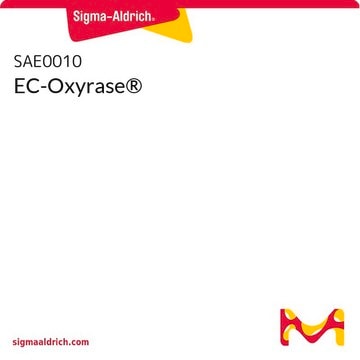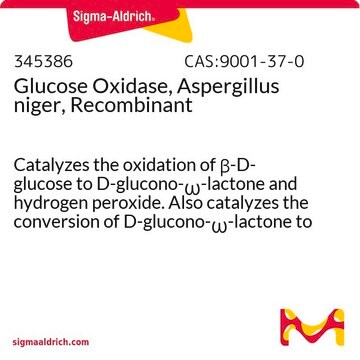P8279
Protocatechuate 3,4-Dioxygenase from Pseudomonas sp.
lyophilized powder, ≥3 units/mg solid
Sign Into View Organizational & Contract Pricing
All Photos(7)
About This Item
CAS Number:
MDL number:
UNSPSC Code:
12352204
NACRES:
NA.54
Recommended Products
biological source
bacterial (Pseudomonas spp.)
form
lyophilized powder
specific activity
≥3 units/mg solid
mol wt
~700 kDa
shipped in
dry ice
storage temp.
−20°C
General description
Protocatechuate 3,4-Dioxygenase belongs to the non-heme iron family of enzymes. The active site of the enzyme contains Fe3+.
Application
Protocatechuate 3,4-Dioxygenase(PCD), from Pseudomonas sp., is used for the enzymatic determination of choline esterase when coupled with phydroxybenzoate hydroxylase. It is used to improve organic fluorophore-stability in single-molecule experiments and is used to study the metabolism of protocatechuate in Rhizobiaceae.
The enzyme has been used to create an oxygen scavenging system along with protocatechuate (PCA) and Trolox. The enzyme employs a nonheme iron center that catalyzes the conversion of PCA and molecular oxygen into β-carboxy-cis,cis-muconic acid, while the antioxidant Trolox suppresses slow blinking and photobleaching of cyanine dyes. It has been used in the preparation of imaging buffer along with DMB-BSA (dynein motility buffer-BSA), ATP and protocatechuate in single molecule motility assay.
Biochem/physiol Actions
Protocatechuate 3,4-Dioxygenase catalyzes the degradation of 3,4-dihydroxybenzoate (protocatechuate) into β-carboxy-cis,cis-muconate.
Physical properties
Structure : Protein with nonheme iron
Inhibitors : Ag+, Hg++, PCMB
Optimum pH : 9.0
Optimum temperature : 60−65°C
pH Stability : pH 7.0−9.0 (25°C, 72hr)
Thermal stability : below 50°C (pH 6.0, 1hr)
Inhibitors : Ag+, Hg++, PCMB
Optimum pH : 9.0
Optimum temperature : 60−65°C
pH Stability : pH 7.0−9.0 (25°C, 72hr)
Thermal stability : below 50°C (pH 6.0, 1hr)
Unit Definition
One unit will oxidize 1.0 μmole of protocatechuate to 3-carboxy-cis,cis-muconate per min at pH 7.5 at 37 °C.
Physical form
Supplied as lyophilized powder.
Analysis Note
Protein determined by biuret.
inhibitor
Product No.
Description
Pricing
Storage Class Code
11 - Combustible Solids
WGK
WGK 3
Flash Point(F)
Not applicable
Flash Point(C)
Not applicable
Personal Protective Equipment
dust mask type N95 (US), Eyeshields, Gloves
Certificates of Analysis (COA)
Search for Certificates of Analysis (COA) by entering the products Lot/Batch Number. Lot and Batch Numbers can be found on a product’s label following the words ‘Lot’ or ‘Batch’.
Already Own This Product?
Find documentation for the products that you have recently purchased in the Document Library.
Customers Also Viewed
G K Podila et al.
Applied and environmental microbiology, 59(8), 2717-2719 (1993-08-01)
A heterologous gene probe encoding the alpha and beta subunits of the Pseudomonas cepacia protocatechuate 3,4-dioxygenase (PCD) was used to detect its homolog in the genome of Bradyrhizobium japonicum USDA110. Three cosmid clones carrying a 2.2-kb BamHI insert showed high
Brevibacterium fuscum protocatechuate 3, 4-dioxygenase. Purification, crystallization, and characterization.
Whittaker J W, et al.
The Journal of Biological Chemistry, 259(7), 4466-4475 (1984)
G Trautwein et al.
Journal of bacteriology, 183(3), 873-881 (2001-02-24)
Protocatechuate degradation is accomplished in a multistep inducible catabolic pathway in Acinetobacter sp. strain ADP1. The induction is brought about by the transcriptional regulator PcaU in concert with the inducer protocatechuate. PcaU, a member of the new IclR family of
Resonance Raman studies on protocatechuate 3, 4-dioxygenase inhibitor complexes
Que J L and Epstein R M
Biochemistry, 20(9), 2545-2549 (1981)
M Contzen et al.
Molecular microbiology, 41(1), 199-205 (2001-07-17)
The genes for a protocatechuate 3,4-dioxygenase (P34O-II) with the ability to oxidize 4-sulphocatechol were cloned from the 4-aminobenzenesulphonate(sulphanilate)-degrading bacterium Hydrogenophaga intermedia strain S1 (DSMZ 5680). Sequence comparisons of the deduced amino acid sequences of both subunits of the P34O-II from
Our team of scientists has experience in all areas of research including Life Science, Material Science, Chemical Synthesis, Chromatography, Analytical and many others.
Contact Technical Service











